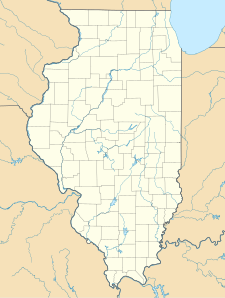Volo Bog
| Volo Bog State Natural Area | |
|---|---|
|
IUCN category Ib (wilderness area)
|
|

The open-water center of Volo Bog, surrounded by tamarack trees
|
|
|
Map of the U.S. state of Illinois showing the location of Volo Bog State Natural Area
|
|
| Location | Lake County, Illinois, USA |
| Nearest city | Ingleside, Illinois |
| Coordinates | 42°21′06″N 88°11′10″W / 42.35167°N 88.18611°WCoordinates: 42°21′06″N 88°11′10″W / 42.35167°N 88.18611°W |
| Area | 1,150 acres (470 ha) |
| Established | 1970 |
| Governing body | |
| Designated | 1972 |
Illinois Department of Natural Resources
Volo Bog State Natural Area is a nature reserve in Illinois, United States, preserving Volo Bog. The bog was designated a National Natural Landmark in 1973 as the only remaining open-water quaking bog in Illinois. The site also contains woodlands, savanna, marshes, prairie restoration areas, shrubland and old fields. Maintained by the Illinois Department of Natural Resources (Illinois DNR), the site is located about a mile west of U.S. Route 12 between the towns of Volo and Fox Lake, Illinois.
The bog itself is 47.5 acres (19.2 ha) in size. It was originally a steep-sided lake created by the melting of a large chunk of glacial ice at the end of the Wisconsonian glaciation. About 6,000 years before the present, a mat of sphagnum moss began to grow out into the water, playing a major role in the evolution of this geological feature from a lake into a bog.
As the sphagnum mat aged and thickened, the developing bog (already poorly drained) became acidic. The bog's changing pH levels encouraged the growth of other acid-loving plant species, such as leatherleaf, certain specialized orchids, and coniferous tamarack trees. The development of a tamarack grove on the edge of the bog signaled further change in the wetland.
By historic times Volo Bog was deep into the process of plant succession. While the center of the bog remained a pool of open water, shallower sections of the sphagnum-moss cushion had begun to provide a substrate for the growth of woody plants, such as tamaracks and poison sumac. The edges of the bog were further developing from a bog into a slightly drier wetland.
...
Wikipedia

